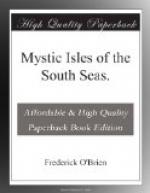From the sea, the village of Papeete, the capital and port, was all but hidden in the wood of many kinds of trees that lies between the beach and the hills. Red and gray roofs appeared among the mass of growing things at almost the same height, for the capital rested on only a narrow shelf of rising land, and the mountains descended from the sky to the very water’s-edge. Greener than the Barbadoes, like malachite upon the dazzling Spanish Main, Tahiti gleamed as a promise of Elysium.
A lighthouse, tall minister of warning, lifted upon a headland, and suddenly there was disclosed intimately the brilliant, shimmering surf breaking on the tortuous coral reef that banded the island a mile away. It was like a circlet of quicksilver in the sun, a quivering, shining, waving wreath. Soon we heard the eternal diapason of these shores, the constant and immortal music of the breakers on the white stone barrier, a low, deep, resonant note that lulls the soul to sleep by day as it does the body by night.
Guardian sound of the South Seas it is, the hushed, echoic roar of a Jovian organ that chants of the dangers of the sea without, and the peace of the lagoon within, the reef.
A stretch of houses showed—the warehouses and shops of the merchants along the beach, the spire of a church, a line of wharf, a hundred tiny homes all but hidden in the foliage of the ferns. These gradually came into view as the ship, after skirting along the reef, steered through a break in the foam, a pass in the treacherous coral, and glided through opalescent and glassy shallows to a quay where all Papeete waited to greet us.
The quay was filled with women and men and children and dogs. Carriages and automobiles by the score attended just outside. Conspicuous above all were the Tahitian and part-Tahitian girls. In their long, graceful, waistless tunics of brilliant hues, their woven bamboo or pandanus hats, decorated with fresh flowers, their feet bare or thrust into French slippers, their brown eyes shining with yearning, they were so many Circes to us from the sea. They smiled and looked with longing at these strangers, who felt curious thrills at this unknown openness of promise.
Louis de Bougainville wrote in his diary at his first coming to Tahiti a hundred and fifty years ago:
The boats were now crowded with women, whose beauty of face was equal to that of the ladies of Europe, and the symmetry of their forms much superior.
Leboucher called to his mother. “Madre mia! Como estas tu?”
Cries rang out in French, in Tahitian and in English. Islanders, returning, demanded information as to health, business ventures, happenings. Merry laughter echoed from the roof of the great shed, and I felt my heart suddenly become joyous.
The girls and women absorbed the attention of passengers not of Tahiti. The New-Zealanders of the crew called excitedly to various ones. Most of the men passengers, tarrying only with the vessel, planned to see a hula, and they wondered if any of those on the wharf were the dancers.




